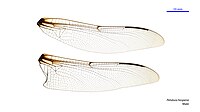
The petaltails of the family Petaluridae are among the most ancient of the extant true dragonflies, having fossil members from as early as the Jurassic, over 150 million years ago.

The caddisflies, or order Trichoptera, are a group of insects with aquatic larvae and terrestrial adults. There are approximately 14,500 described species, most of which can be divided into the suborders Integripalpia and Annulipalpia on the basis of the adult mouthparts. Integripalpian larvae construct a portable casing to protect themselves as they move around looking for food, while annulipalpian larvae make themselves a fixed retreat in which they remain, waiting for food to come to them. The affinities of the small third suborder Spicipalpia are unclear, and molecular analysis suggests it may not be monophyletic. Also called sedge-flies or rail-flies, the adults are small moth-like insects with two pairs of hairy membranous wings. They are closely related to the Lepidoptera which have scales on their wings; the two orders together form the superorder Amphiesmenoptera.

The beautiful demoiselle is a species of damselfly belonging to the family Calopterygidae. It is found in Europe, North Africa, and Western Asia. It is often found along fast-flowing waters.

The Gomphidae are a family of dragonflies commonly referred to as clubtails or club-tailed dragonflies. The family contains about 90 genera and 900 species found across North and South America, Europe, Asia, Australia, and Africa. The name refers to the club-like widening of the end of the abdomen. However, this club is usually less pronounced in females and is entirely absent in some species.

Petalura gigantea, the giant dragonfly or south-eastern petaltail, is a species of dragonfly in the family Petaluridae from southeastern Australia. Males have body length of 6–7.5 cm (2.4–3.0 in) and a wingspan up to 11 cm (4.3 in), while females have body length of 8–9 cm (3.1–3.5 in) and a wingspan up to 12.5 cm (4.9 in). This makes it a very large species of dragonfly, although it is exceeded by a few other species, including the closely related northeast Australian giant petaltail.
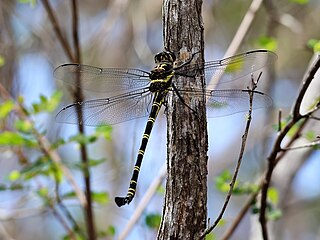
Petalura ingentissima, the giant petaltail, has been described as the world's largest dragonfly, with a wingspan of 160 mm. It is found in Queensland, Australia.
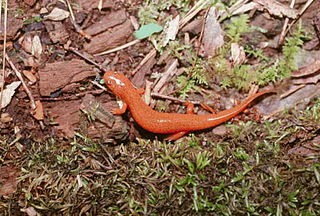
The mud salamander is a bright red salamander of the family Plethodontidae. It is found in streams, seeps and swamps and underneath logs, rocks and leaves. It is endemic to the eastern half of the United States with one isolated population in central Mississippi. Mud salamanders are rarely seen plethodontids that inhabit muddy wetland and riparian habitats. Mud salamanders don’t generally live above 700 meters in elevation in the Appalachian Mountains, resulting in two geographically isolated populations. Mud salamanders have short stocky bodies ranging from 7.5 to 16 cm long. Body color ranges with age and locality. There are four subspecies in the mud salamander complex, namely the Gulf Coast mud salamander, rusty mud salamander, Midland mud salamander and the eastern mud salamander. Mud salamanders are ectothermic, meaning that they cannot control their body temperature and it fluctuates with the temperature. The mud salamander is readily confused with two other species, the red salamander and the spring salamander.
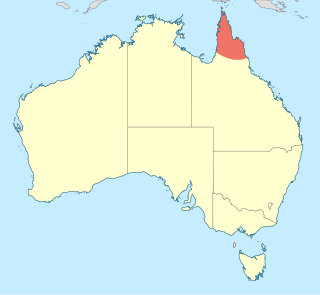
Petalura pulcherrima is a species of Australian dragonfly in the family Petaluridae, commonly known as a beautiful petaltail. It is a very large and slender dragonfly, mostly black or dark brown with yellow markings and its eyes widely separated on top of its head. It has clear wings and a very long, narrow pterostigma.

Petalura is a genus of very large dragonflies in the family Petaluridae. Species of Petalura are brown or black with yellow markings and usually clear wings. The anal appendages of the males are broad and leaf-like giving them their common name of petaltails. They are endemic to south-western and eastern Australia.
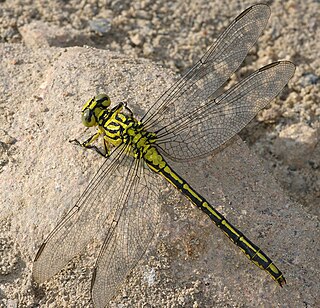
Gomphus flavipes, the river clubtail or yellow-legged dragonfly, is a species of dragonfly in the family Gomphidae. It is found in Europe. Its natural habitat are rivers and large streams. The dragonfly flies from June to September depending on the location.

Petalura litorea, commonly known as the coastal petaltail, is an endangered Australian species of dragonfly from the family Petaluridae.

Choristhemis flavoterminata, the yellow-tipped tigertail, is a species of dragonfly from the family Synthemistidae found in New South Wales and Queensland, Australia. Yellow-tipped tigertails prefer a warm, wet climate and often reside near rivers where they also lay their eggs. Specimens of this type of dragonfly are noted in the A.N. Burns Collection in Museum Victoria.

Tonyosynthemis ofarrelli, more commonly known as the slender tigertail, is a species of Odonata from the family Synthemistidae. It is found in Queensland, Australia, along the eastern coast. They tend to live along or near freshwater streams or rivers, which is also where Odonata tend to lay their eggs.

Progomphus borealis is a species of dragonfly in the family Gomphidae. This dragonfly species is commonly known as the gray sanddragon.

Gomphurus externus, the plains clubtail, is a species of dragonfly in the family Gomphidae.

The tau emerald is a species of dragonfly in the family Corduliidae. Corduliidae is the only family not a clade within the Infraorder Anisoptera. The species was first described by Edmond de Sélys Longchamps in 1871.

Diphlebia euphoeoides, sometimes spelled Diphlebia euphaeoides, known as the tropical rockmaster, is an Australian species of broad winged damselfly. It is one of a group known as the azure damselflies. It is found in Queensland (Australia) and Papua New Guinea. It typically occurs near lakes, waterfalls or streams at relatively low altitudes, and is occasionally seen near dry pools.
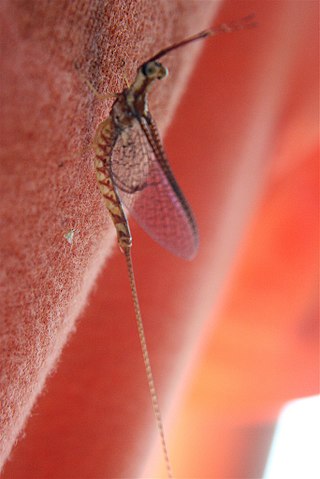
Hexagenia limbata, the giant mayfly, is a species of mayfly in the family Ephemeridae. It is native to North America where it is distributed widely near lakes and slow-moving rivers. The larvae, known as nymphs, are aquatic and burrow in mud and the adult insects have brief lives. They are often referred to as fish flies around the Great Lakes as they tend to cause the areas around water to smell like rotten fish.

Austrogomphus gordoni, also known as Austrogomphus (Xerogomphus) gordoni, is a species of dragonfly of the family Gomphidae, commonly known as the western red hunter. It inhabits streams and pools in Western Australia.


